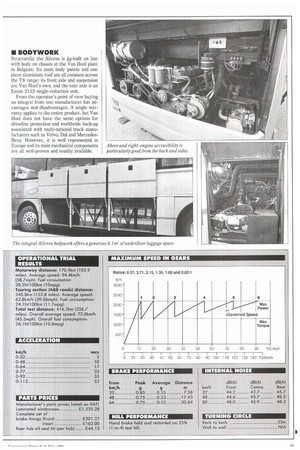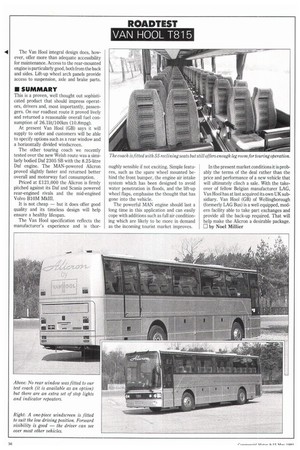Von Hool's Akron integral coach will offer an interesting alternative
Page 35

Page 36

Page 37

Page 38

If you've noticed an error in this article please click here to report it so we can fix it.
to users of its bodies on other chassis. It has much to commend it to operators and passengers alike.
• Van Hool is unusual in the ranks of coach manufacturers in that it produces a range of integral coaches in direct competition with those fitted with its own bodywork on chassis by the likes of Daf and Scania.
The second coach to be tested on CM'S new Wye Valley test route is the latest version of the Van Hool T8 integral which, in conventional single-deck form, is marketed as the Alicron. Our test vehicle has been built as a demonstrator for Van Hool (UK) and is fitted with 55 Van Hool LabeIlux reclining seats. Its specification includes double-glazing, central heating with oil fired Webasto pre-heater and timer, and a Blaupunkt audio set-up incorporating radio/cassette player, a two-microphone PA system and 12 individual rackmounted speakers.
The rear window is blanked out, making room for an extra set of highlevel brake lights and indicator repeaters. Up front is a low driving position and a large, one-piece windscreen with an upper set of wipers for the benefit of front seat passengers.
Visually the coach is indistinguishable from a Van Hool Alizee-bodied vehicle on an alternative chassis: the interior specifications are up to Van Hool's usual high standard. The instrument display is comprehensive and well arranged; as is now standard practice the interior trim is "soft" with the ceiling, side walls and racks covered in moquette.
As the body styling has remained substantially the same for over a decade it offers no surprises: as a minor criticism we do find the luggage racks a little shallow. Of course it could be argued that this is a safety feature as it discourages passengers placing heavy objects on the racks which could be a danger in an emergency.
Van Hool integrals have previously been offered in the UK with Daf, MAN, MercedesBenz and Cummins engines. Our test coach is fitted with the turbocharged TOH version of MAN's D2866 engine rated at 229kW (311hp). Charge-cooled LOH and LXOH versions are available producing 260kW (354hp) and 274kW (354hp). The TOH drives via ZF's familiar S 6.90 synchromesh box; the seven-speed ZF S6 150 C box is fitted when the charge-cooled engines are specified.
• PERFORMANCE
CM's test route starts with a 170km dash along the M4 from Heathrow to the Aust service area by the Severn Bridge. Despite some fairly vicious cross winds the unladen highliner coach proved easy to control at its legal maximum of 112km/h (70mph). The most immediately noticeable features from the driver's point of view are the power of the big MAN motor and a total lack of engine noise—our noise meter recorded below 50dB(A) at the rear of the saloon at 80ktn/h (50mph).
The MAN-powered Alicron would be capable of nearly 145Icm/h (90mph) but is governed by the now compulsory limiter in fifth and sixth gears. It is important to monitor the rev counter to avoid driving for long periods in too low a gear: at 113km/h (70mph) the engine runs efficiently at just below 1,800rpm.
Fuel consumption over this high-speed section of the route was a reasonable 28.2 lit/100m (10mpg). Our average speed of 94.41un/h (58.7mph) was held down by the inevitable crop of road works.
The big engine certainly proved its worth on the twisty and hilly A466 running through the picturesque Wye valley. The gearchange was fairly stiff — the coach had covered less than 2,0001un — but the change is precise and engine flexibility allows gearchanges to be kept to a minimum. There was enough power right down to 800rpm. At the other end of the scale the MAN unit could push the Van Hool from 0-801un/h (50mph) in 23 seconds and to 1131cm/h (70mph) in 52 seconds.
On single-carriageway rural roads the Van Hool purred along at 80km/h (50mph) in top with the engine ticking over at a comfortable 1,400rpm.
The handling too is good, with little roll and no forward pitch or bounce. Over the tricky ride-and-handling course stability was particularly reassuring. The power steering has plenty of feel and the lock is good. Some front tyre noise is noticeable, however, even when cornering at relatively low speeds.
Braking, aided by the Telma Focal-type retarder with foot and hand control was impressive, although the brakes did lock during our programme on full-pressure stop on the test track. ABS is an option that can be added retrospectively with no need to remove the axles.
• DRIVER COMFORT
The 'low' driver position is still high enough to give a view over most other vehicles and visibility is above average, except when rejoining a main road from an angled intersection when it is impossible to see through the first passenger side window from the driving seat due to the height of the bottom of the window. Under most conditions, however, we found little for the driver to criticise.
A suspension seat and a steering wheel adjustable for rake and height accommodate drivers of most sizes in comfort. The instru ment display is comprehensive and instruments are well grouped, although our tester did have to lower his eyes to actively monitor them.
An intermediate-speed hold-facility is fitted and proved a boon when travelling at the legal maximum speed on dual and singlecarriageway roads.
This is controlled by a simple flick switch that can be operated when the desired maximum speed is reached. For some reason, however, the switch is unmarked and gives the impression that somebody at the manu
facturers added it as an afterthought after popping out to his local accessory shop for the cheapest control he could find. The end result is not really in keeping with the rest of the dash, even though the cruise control works well.
Getting underway on the 25% (1-in-4) test hill during our test track programme was no problem but did require some driver concentration to overcome not being able to hear the engine and the delay in the spring hand brake releasing.
• PASSENGER COMFORT
With all 55 reclining seats fitted passenger leg room is still adequate for touring operations. The combination of double glazing, a well specified heating and ventilation system and the luxurious ride provided by Van Hool's air suspension make the Alicron a more pleasant vehicle to ride in than most family cars.
The plug-type entrance door and the driver's window are draft free and wind noise is not intrusive. Full draw curtains add to the passenger appeal.
The lack of a rear window is unlikely to be noticed by passengers who rarely look back during a coach tour; neither is it a problem for the driver as the view from the mirrors is fine.
The integral design has the advantage of maximising the luggage space. This Alicron offers 8.3m3 between the axles, which should easily meet the needs of 55 passengers and crew.
• BODYWORK
Structurally the Alicron is jig-built on line with body on chassis at the Van Hoot plant in Belgium. Its main body panels and one piece aluminium roof are all common across the 18 range; its front axle and suspension are Van Hool's own, and the rear axle is an Eaton 2123 single-reduction unit.
From the operator's point of view buying an integral from one manufacturer has advantages and disadvantages. A single warranty applies to the entire product, but Van Hool does not have the same options for driveline protection and worldwide back-up associated with multi-national truck manufacturers such as Volvo, Daf and MercedesBenz. However, it is well represented in Europe and its main mechanical components are all well-proven and readily available. The Van Hool integral design does, however, offer more than adequate accessibility for maintenance. Access to the rear-mounted engine is particularly good, both from the back and sides. Lift-up wheel arch panels provide access to suspension, axle and brake parts.
• SUMMARY
This is a proven, well thought out sophisticated product that should impress operators, drivers and, most importantly, passengers. On our roadtest route it proved lively and returned a reasonable overall fuel consumption of 26.11k/100km (10.8mpg).
At present Van Hoot (GB) says it will supply to order and customers will be able to specify options such as a rear window and a horizontally divided windscreen.
The other touring coach we recently tested over the new Welsh route was a similarly bodied Daf 2305 SB with the 8.25-litre Daf engine. The MAN-powered Micron proved slightly faster and returned better overall and motorway fuel consumption.
Priced at £121,000 the Micron is firmly pitched against its Daf and Scania powered rear-engined rivals and the mid-engined Volvo BlOM MkIII.
It is not cheap — but it does offer good quality and its timeless design will help ensure a healthy lifespan.
The Van Hool specification reflects the manufacturer's experience and is thor oughly sensible if not exciting. Simple features, such as the spare wheel mounted behind the front bumper, the engine air intake system which has been designed to avoid water penetration in floods, and the lift-up wheel flaps, emphasise the thought that has gone into the vehicle.
The powerful MAN engine should last a long time in this application and can easily cope with additions such as full air conditioning which are likely to be more in demand as the incoming tourist market improves.
In the present market conditions it is probably the terms of the deal rather than the price and performance of a new vehicle that will ultimately clinch a sale. With the takeover of fellow Belgian manufacturer LAG, Van Hool has at last acquired its own UK subsidiary. Van Hool (GB) of Wellingborough (formerly LAG Bus) is a well equipped, modern facility able to take part exchanges and provide all the back-up required. That will help make the Akron a desirable package. 0 by Noel Millier












































































































